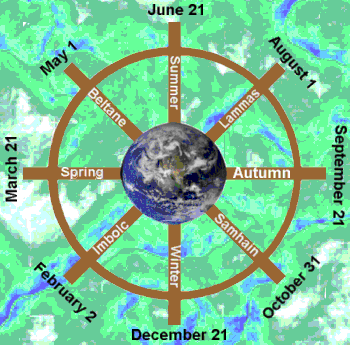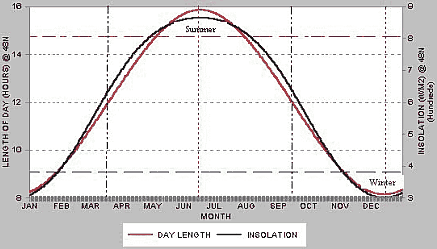 |
 |
| Home | Welcome | What's New | Site Map | Glossary | Weather Doctor Amazon Store | Book Store | Accolades | Email Us |
 | ||||||||||||||||||||||||||||||||||||
Weather Almanac for January 2003THE WHEEL OF THE YEAR
The ancients who venerated the Sun placed their year's beginning at a point along its annual hill-and-valley trek through the sky that made sense to them. As they watched the Sun rise and fall through the year, few understood that the variation came from the cock-eyed tilt of our planet as it spun its daily-cycle circle round old Sol, but they found ways to "plot" the solar journey. They left us inscrutable megaliths like Stonehenge, which are likely stone DayTimers set to remind their builders of the exact date of the solstices and/or equinoxes. Millennia before hours were first struck and we began parsing time into minutes and seconds, the year was divided into logical divisions, first halves, then quarters and finally, like spokes of a great wheel, into eighths. Defining The SpokesThe halves and quarters comprise what we today call seasons — initially, two seasons were likely recognized: hot and cold; wet and dry; high sun and low sun. Europeans saw four divisions and called them Winter, Spring, Summer, Autumn (or Fall). Additional subdivisions recognized what we call the cross-quarter days. These cut the annual pie into eighths. Unlike the solstices which are very visible events in the middle and high latitudes, the equinoxes and cross-quarter days requiring greater degrees of observational sophistication. The prime spokes of the Wheel of the Year are set at the solstices and equinoxes, solar positions easily measured today; their dates/times are precisely determined. Equinoxes occur when the Sun stands directly over the Equator. The summer and winter solstices (as defined in the Northern Hemisphere) mark the highest and lowest sun positions in the annual sky when the Sun is over the Tropics of Cancer and Capricorn, respectively. The media in North America have taken these astronomical moments to signal an "official" starts for the Spring, Summer, Autumn and Winter weather seasons, as if some Arthurian decree had been issued from Camelot across the land. But the atmosphere does not follow human, or heavenly decree, promptly or with regularity. Thus, for more practical reasons, most meteorologists and climatologists define the primary seasons as beginning with the month in which the equinox/solstice occurs plus the two following months. Their year runs December 1 to November 30 because December weather patterns more logically fit into the winter of the following calendar year. The ancients saw things a little differently. The solstices were mid-season dates rather than start dates. Hence, Shakespeare's A Mid-Summer Night's Dream. Using only the sun for guidance, the Summer Solstice signalled the midpoint of the solar-dominated days; the Winter Solstice pinpoints the central day of the night-dominated days and festivals were celebrated accordingly. The Spring Equinox signals the day the Sun springs above the Equator in the North and daytime begins to exceed darktime, the Autumnal Equinox, the day the sun falls below the equator (from a northern perspective) and dark again dominates.  Of the remaining wheel's spokes, the cross-quarter days are lesser known today, at least in their original context and level of observation. One, Samhain in the Celtic tradition and All Hallow's Eve in the early Christian traditions, is fast becoming North America's most celebrated non-holiday: Halloween. Another, definitely gets a load of press each year. The Celts called it Imbolc, the Christian Church, Candlemas. We know it best as Groundhog Day. Lesser known is Beltane or May Day, and almost forgotten is Lammas, the first harvest festival celebrated at the beginning of August. Defining The Solar SeasonsBear with me as I pull out a little mathematics here. If we plot the number of hours of expected daylight (that is when the sun is actually above the horizon) over the year, we get a sine wave pattern as shown below. (Note, I remain Northern-biased and offer apologies to those readers from south of the Equator.)  The peak of the curve is at the Summer Solstice; the lowest point, at the Winter Solstice. Where the graph crosses the 12-hour mark, midway between the Solstices, we have the equinoxes. [Please, no emails trying to catch me on this. I know the atmosphere plays a trick on us and produces a sun-mirage at rising and setting that makes the equinox day a handful of minutes longer than the night. For more on this, see my explanation elsewhere on this site.] So much for astronomical concerns. These dates fall on or about (to use that court legalese) the 21st day of March, June, September and December. Because the year is actually about a quarter day longer than 365, these dates would roll through the calendar year slowly over millennia. The genius of the Gregorian calendar is that it corrects for this procession by adding, and occasionally ignoring, leap years, and thus these astronomical events remain on a rather constant date on the calendar. The astronomers having done their duty, it is now time for meteorologists and climatologists to take over. Seasons can be defined in a myriad of different ways depending on the ultimate application and need not all be of equal length. This concept has even moved into the non-science realm. For example, the baseball season is divided into off-season, spring training, regular season and playoffs or championship season. Then, the off-season returns, and the cycle begin all over again, a rolling procession that repeats, more or less regularly, each year. Ice hockey follows the same four seasons (though spring training is called training camp), but they occur approximately in opposition to baseball's seasons. Weather-related seasons are most commonly defined by North Americans in terms of temperature regimes: with Summer the hot season, Winter the cold, and Spring and Autumn transition periods. (On the Indian Subcontinent, two seasons, wet and dry — known as the monsoons — form the year with abrupt rather than slow transitions.) If I added a mean temperature curve to the above solar chart, it would show a similar sine-wave pattern offset to the right about a month. A good second choice for seasonal markers would be the solar year as measured by length of daylight or potential daily solar energy received. Now, if I divide the year into quarters and define the quarter with the most solar light/energy as solar summer, the least solar light/energy quarter as solar winter, and two transitional quarters of springing sunlight and falling sunlight, I would find the following:
Our Wheel of the Year now has eight spokes, each meeting the Gregorian Calendar at a specific date. The four "seasonal" dates we know well. The recognized four cross-quarter dates are given below, but note they are not exactly 45 days from the solstice/equinox. (And because the Earth's movement through its orbit is not at a constant speed either, the number of days between a solstice and equinox is not always exactly 91.) The cross-quarter dates of Celtic and other traditions likely were originally set at these solar season start dates and kept there as the calendar evolved. [For more information on any of the Spokes, click on it in this chart to go to my focus on the date.]
We start the year — January 1 — at no particularly interesting point of the solar year cycle, except perhaps, perihelion, the Earth's closest approach to the Sun. Though as I said, it doesn't much matter where on a circle you begin. The ancient Egyptians started their year on the day that Sirius, the dog-star and second brightest in the heavens, rose in the same sky-place as the Sun. The English originally started the year March 25 but moved it to January 1 around 1772. A number of cultures and traditions that follow a mostly solar calendar begin the year at differing points on the Solar wheel. In some, Spring Equinox begins the year. In others, it is Yule or the Winter Solstice that marks the start. For a few others, Samhain/All Hallow's Eve marks the transition. And those that follow lunar or lunar/solar calendars, such as the Chinese and Islamic traditions, have other starting dates which may vary over the years. I personally think of Groundhog Day, the approximate start of solar spring as the start of my personal year because the dark-day period has ended and the daylight begins a very rapid increase in length. For that reason, I had planned to launch The Weather Doctor on that date, and I still consider it the official site anniversary date. (I actually launched the site a few weeks early to provide materials on ice storms during the Great Ice Storm of 1998.) So with this almanac piece, I complete the fifth roll of The Weather Doctor's Yearly Wheel. As I cycle into Year Six, I see work behind me to be proud of...and more ahead to write. To all my readers, regular or just dropping by, I wish a most healthy, happy and prosperous New Year. May this cycle bring Peace on Earth, Goodwill to All and may the rainbow touch your shoulder each day. Learn More From These Relevant Books
|
||||||||||||||||||||||||||||||||||||
 |
To Purchase Notecard, |
Now Available! Order Today! | |
 |
 |
NEW! Now |
The BC Weather Book: |


